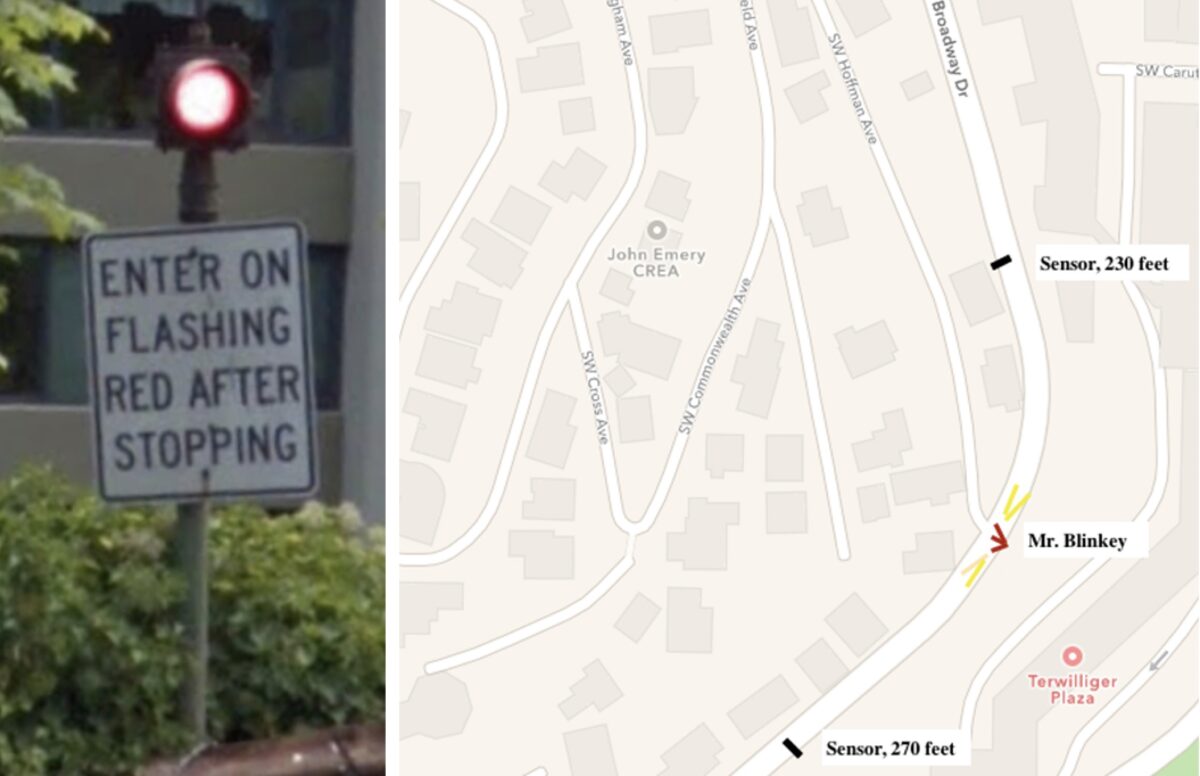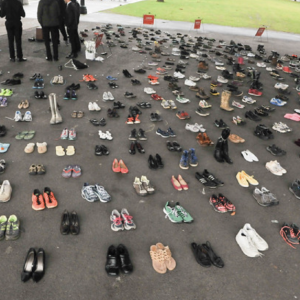
Mr. Blinky was a unique traffic control device located at the intersection of SW Broadway Drive and SW Hoffman Avenue. Drivers along the SW Broadway Drive toboggan run may have noticed that they never seemed to get a red light at Hoffman—only those ever-present flashing yellows. Well, you can thank Mr. Blinky for that.
You see, the genius of Mr. Blinky was that he was designed to never inconvenience a Broadway driver with the nuisance of having to stop, say for a pedestrian or another driver trying to enter the roadway. As a 1976 report from a Senior Traffic Engineer to an insurance company states,
Due to nearly total lack of visibility … a device was developed that maintains a flashing yellow caution indication for Hoffman Street and changes to flashing red for all directions only when no traffic is present on Broadway Drive. The signal will rest in flashing red all directions until a vehicle approaches on Broadway Drive.
So someone driving on Broadway never saw a flashing red because their presence triggered the overhead flashing yellow from hundreds of feet preceding Hoffman.
Advertisement
Although he violated all principles of active transportation planning, it was hard not to have a grudging respect for the cleverness of his design.
On a personal note, I had the privilege of spending 45 minutes with Mr. Blinky a couple of years ago. I was timing the duration of his two phases (solid red and flashing red) and although the phases weren’t random, they were completely unpredictable. During peak traffic, a pedestrian or Hoffman driver could easily wait about three minutes for through traffic on Broadway to be clear long enough for Mr. Blinky to signal it was safe to proceed into the blind curve.
Nobody is sure when Mr. Blinky was born, but his death marks the end of an era. It is fitting that he finally broke during the same week that the draft Pedestrian Design Guide revisions were released. Even though Mr. Blinky presided over a failed intersection, and I knew he was obsolete (he had already been around for over a half century) his death came as a shock to me. Maybe he will finally be replaced by a design that considers the safety of people walking, and riding a bike or e-scooter.
Mr. Blinky might have been an anachronistic, mid-twentieth century traffic control device, but damn it, he was our anachronistic, mid-twentieth century traffic control device. And although he violated all principles of active transportation planning, it was hard not to have a grudging respect for the cleverness of his design.
Mr. Blinky, dear friend, I hadn’t realized how fond of you I had become. Rest in Peace.






Thanks for reading.
BikePortland has served this community with independent community journalism since 2005. We rely on subscriptions from readers like you to survive. Your financial support is vital in keeping this valuable resource alive and well.
Please subscribe today to strengthen and expand our work.
I’m glad that it’s now a stop sign controlled intersection. That should have been done years ago. However, PBOT really needs to install a second stop sign in the opposite side of the street for uphill traffic. The one they put in is just resting on a concrete weight and it is located out of the sightlines of traffic that is rounding the bend and too close to the vehicle travel lane. The stop sign has clearly been hit multiple times in the last couple weeks, and it’s not pointing the correct direction.
PBOT has been notified the sign is hard to see, mainly due to bushes just downhill. A big STOP painted on the roadway would be nice.
Studded tires will make short work of that paint!
Aloha Lisa,
Thanks for a bit of traffic wonk history…I tried to open the attached 1976 report but only the first page is in the link. (Is that everything, as it ends in mid sentence?)
Farewell ‘Mr. Blinky’,
from ‘Mr. Biki.’ [Todd]
https://gobiki.org
Brilliant 🙂
I’m glad you appreciated the piece, Hami, I had a lot of fun writing it.
Loved it!
Lisa, there are so many attitudes you could have held as you gave us this information in your article. I am so glad you chose the one you did. Thank you, Lisa!
Thank you Janowa. For all the dry humor, it does come from a sincere place. My internet-shy transportation buddy and I have spent a lot of time on this intersection (I didn’t mention the 24-hour traffic count we did using a neighbor’s security camera.) But even just between the two of us, the byword was always “respect the signal.” We both like old machines and made a point of never speaking ill of Mr. Blinkey.
Sorry but I can’t understand, even after reading your description several times, how Mr Blinky worked. But I guess the issue is moot since he is dead. I take it the point was never to inconvenience a driver but I’m not clear how it accomplished that feat. I thought maybe it was like the loops on SW Barbur, before the two narrow bridges, that detect bikes and flash a yellow light, but again it’s not clear to me.
in essence, mr. blinky was a stop sign most of the time – but when a car on broadway approached, he turned to a yellow caution light for broadway and a red stop light for hoffman. this meant that as a broadway driver, the sensors switched the light for you to proceed before you got there; as a hoffman driver, you normally could pull out after stopping, but the sensor tripping the solid red warned you a car was coming and to hold until it passed.
it was set up to never stop broadway traffic and rarely did… the only times i ever stopped were due to a vehicle trying to turn and not being quick enough. or a stuck one!
Fred, it is hard to wrap your head around even if you have seen it in action. The place to start is this: it was designed so that Broadway Drive traffic didn’t ever have to stop. So Mr. Blinkey signaled an absence of cars on Broadway to the Hoffman driver (Hoffman intersects Bway in an almost completely blind curve). Hoffman doesn’t have a sensor. So the Hoffman driver is waiting for a break in the traffic; Mr. Blinkey signaled that break (according to his little algorithm).
There were two sets of signals: Mr. Blinkey faced Hoffman, and a pair of overhead lights (which can be flashing red or flashing yellow) face the uphill and downhill Broadway traffic. When a car tripped a Bway sensor, the overhead lights turned to flashing yellow, and Mr. Blinkey turned to solid red. Both remained in that phase for a set number of seconds (calculated from the distance between the sensor and Hoffman, and a minimum speed of 15 mph).
In practice, with today’s traffic volumes, Mr. Blinkey often appeared to be on the fritz. His flashing red, safe to proceed, phase could last as little as one, two, three, four seconds. Area residents knew to ignore Mr. Blinkey at certain times and just use the two convex mirrors. Someone unfamiliar with the signal, however, would eventually conclude he was broken. I saw one Hoffman driver put it in reverse in an attempt to re-trigger a non-existent sensor.
Good luck understanding all that. And that was part of the problem, nobody understood the logic.
It was so great to see an all-way stop when I came down the hill Monday. Even better to know the history now! I had no idea these lights even changed.
This article on the SWHRL web page is more direct than mine: https://www.swhrl.org/wp/sw-hoffman-traffic-light-issues/
Turns out that the Mr. Blinkey signal configuration has been around since at least 1954!
This is great!
mr. blinky is now permanently gone; the stop signs will control this intersection from now on. great news for pedestrians – thanks, pbot!!!